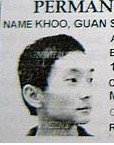In The Cut (2003)
"FILMED 100% IN NEW YORK CITY". I really liked the often drifting handheld photography in this urban thriller directed by Jane Champion (of 1993's The Piano). Although the film’s general structure fits the thriller genre, it’s strongest impressions were made by the lead character’s melancholia; Frannie’s stream of consciousness is the central mystery. Therefore, it is also a character film, one that references Virginia Woolfe on several occasions:  Frannie’s fruitless effort to teach the novel “The Lighthouse” & Frannie’s intimate relationship with her sister Pauline (Jennifer Jason-Leigh). The on-location Manhattan settings, the subdued lighting & prevalent use of shadows, the narrow focal depth of long lenses, and the floating camera eye provides a unique voyage into Frannie’s state of being and family history.
Frannie’s fruitless effort to teach the novel “The Lighthouse” & Frannie’s intimate relationship with her sister Pauline (Jennifer Jason-Leigh). The on-location Manhattan settings, the subdued lighting & prevalent use of shadows, the narrow focal depth of long lenses, and the floating camera eye provides a unique voyage into Frannie’s state of being and family history.
Meg Ryan plays the protagonist as if in a state of sustained hallucination; an impressively subdued performance.
It struck me that the tattooed-forearm “film device” is not explicitly acknowledged by other characters besides the lead until 45 minutes into the film; another sign of how the thriller structure is incidental. This film will appeal to women more than men despite its overt sensuality & the graphic sex scenes. It does not follow a “female structure”, but the climax is more cathartic than explosive.
http://us.imdb.com/title/tt0199626/


 contains Jennifer Lopez's best role in a film. It made me want to watch more films with her playing lead. The Jennifer Lopez from the late 90s was slightly different: she was less skinny & more "realistic"-looking. Either in full lipstick & eye makeup or looking like she had truly just woken up from normal-person slumber (as opposed to movie-sleeping in makeup), Karen Sisco (Lopez) is stunning. Further, Karen exudes an undeniable, working-girl sexuality that has seldom graced the big screen, at least not lately.
contains Jennifer Lopez's best role in a film. It made me want to watch more films with her playing lead. The Jennifer Lopez from the late 90s was slightly different: she was less skinny & more "realistic"-looking. Either in full lipstick & eye makeup or looking like she had truly just woken up from normal-person slumber (as opposed to movie-sleeping in makeup), Karen Sisco (Lopez) is stunning. Further, Karen exudes an undeniable, working-girl sexuality that has seldom graced the big screen, at least not lately.

